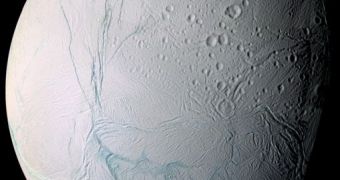Images of one of Saturn's moon, brought back by NASA's Cassini orbiter, have recently spawn some of the most fierce debates regarding the solar system exploration program. German astrophysicists argue that there is conclusive evidence that Enceladus, a small moon measuring only 504 kilometers in diameter, may have liquid water beneath its surface.
Enceladus presents a surface covered by a bright white shell of water ice, probably one of the strongest light-reflecting surfaces in the whole solar system. In fact, it is so reflective that its surface temperature only rises to about -193 degrees Celsius, making it the coldest of all other moons of Saturn. Most of the regions of the terrain are relatively smooth, thus young, but it also presents scattered linear cracks and craters created by impacts with different space rocks.
While looking for evidence of the presence of a atmosphere on the small moon, during two separate stellar occultations, Cassini observed what seemed to be plumes of water vapor rising up from the surface in the general regions near its south pole, ejecting material in the form of crystal jets as high as a few hundred kilometers into space. Astrophysicists took in consideration the possibility of a 'cryo-volcanism' phenomena, through which icy particles of water were being mixed during the eruption, which could also explain why the ejected material is traveling slower through the void.
A new theory proposed by Jurgen Schmidt from the University of Potsdam, suggests that water vapor and ice grains are being mixed and then forced through funnels in the icy crust. But, due to the fact that icy grains are much heavier than the vapors, they rub to the wall of these funnels. Through this process particles are slowed down.
On the other hand, the new model also implies that, for this process to take place, beneath the surface of the moon should exist a mix of liquid water, water ice and water vapor in a state of equilibrium. Similar to the model proposed in the case of Jupiter's moon Europa, the required heat is generated through tidal heating, meaning that the extreme gravitational pull of Saturn stretches and squeezes it, determining friction that causes water to heat up.
Additional support for the theory must be looked for in the grooves that stretch across Enceladus surface, as their temperature is about 60 degrees Celsius higher than the temperature of the surface, thus the inner regions should be even warmer. When talking about liquid water, astrophysicist immediately make connections with the possibility of existence of life. Enceladus could present a sub-surface ocean, but the possibility that life could have evolved higher than microbial life on this remote moon is rather slim.

 14 DAY TRIAL //
14 DAY TRIAL //